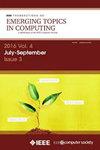CLOG-CD: Curriculum Learning Based on Oscillating Granularity of Class Decomposed Medical Image Classification
IF 5.4
2区 计算机科学
Q1 COMPUTER SCIENCE, INFORMATION SYSTEMS
IEEE Transactions on Emerging Topics in Computing
Pub Date : 2025-04-25
DOI:10.1109/TETC.2025.3562620
引用次数: 0
Abstract
Curriculum learning strategies have been proven to be effective in various applications and have gained significant interest in the field of machine learning. It has the ability to improve the final model’s performance and accelerate the training process. However, in the medical imaging domain, data irregularities can make the recognition task more challenging and usually result in misclassification between the different classes in the dataset. Class-decomposition approaches have shown promising results in solving such a problem by learning the boundaries within the classes of the data set. In this paper, we present a novel convolutional neural network (CNN) training method based on the curriculum learning strategy and the class decomposition approach, which we callCLOG-CD:基于类分解医学图像分类振荡粒度的课程学习
课程学习策略已被证明在各种应用中是有效的,并在机器学习领域引起了极大的兴趣。它具有提高最终模型性能和加速训练过程的能力。然而,在医学成像领域,数据不规则性会使识别任务更具挑战性,并且通常会导致数据集中不同类别之间的错误分类。类分解方法通过学习数据集类的边界,在解决这类问题方面显示出了有希望的结果。本文提出了一种基于课程学习策略和类分解方法的卷积神经网络(CNN)训练方法,我们称之为CLOG-CD,以提高医学图像分类的性能。我们在四种不同的不平衡医学图像数据集上评估了我们的方法,如胸部x线(CXR)、脑肿瘤、数字膝关节x线和组织病理学结直肠癌(CRC)。CLOG-CD利用从类的分解粒度中学习到的权值,并且从降序到升序完成训练(即反课程技术)。我们还研究了基于不同加速因子和速度功能课程的方法的分类性能。我们使用了两个预训练的网络,ResNet-50和DenseNet-121,作为CLOG-CD的主干。使用ResNet-50的结果表明,与其他训练策略相比,CLOG-CD能够提高分类性能,CXR数据集的准确率为96.08%,脑肿瘤数据集的准确率为96.91%,数字膝关节x射线数据集的准确率为79.76%,CRC数据集的准确率为99.17%。此外,使用DenseNet-121, CLOG-CD在CXR、脑肿瘤、数字膝关节x线和CRC数据集上的准确率分别达到94.86%、94.63%、76.19%和99.45%。
本文章由计算机程序翻译,如有差异,请以英文原文为准。
求助全文
约1分钟内获得全文
求助全文
来源期刊

IEEE Transactions on Emerging Topics in Computing
Computer Science-Computer Science (miscellaneous)
CiteScore
12.10
自引率
5.10%
发文量
113
期刊介绍:
IEEE Transactions on Emerging Topics in Computing publishes papers on emerging aspects of computer science, computing technology, and computing applications not currently covered by other IEEE Computer Society Transactions. Some examples of emerging topics in computing include: IT for Green, Synthetic and organic computing structures and systems, Advanced analytics, Social/occupational computing, Location-based/client computer systems, Morphic computer design, Electronic game systems, & Health-care IT.
 求助内容:
求助内容: 应助结果提醒方式:
应助结果提醒方式:


